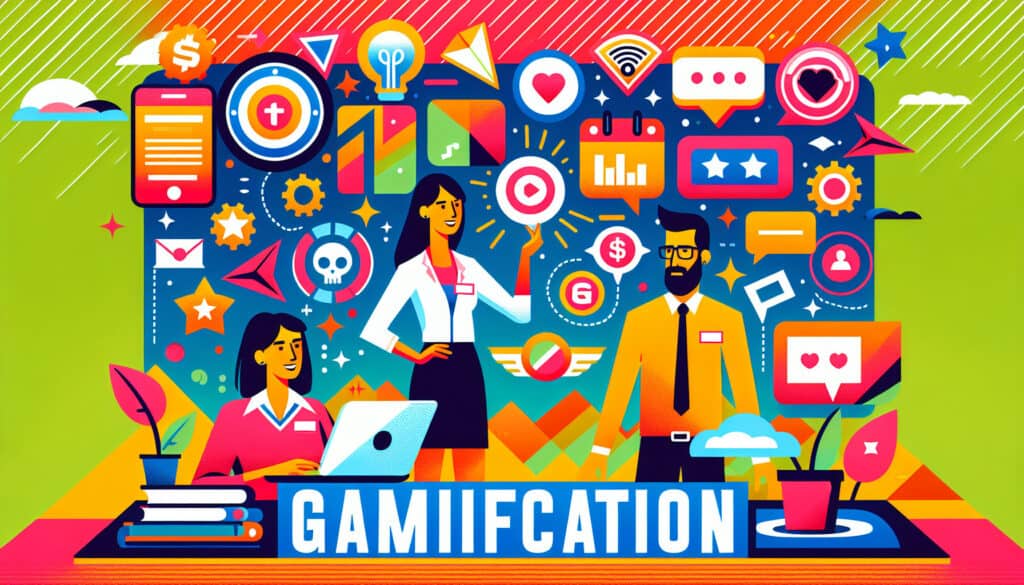To apply game-design elements and principles in non-game contexts.
- Methodologies: Engineering, Ergonomics
Gamification

Gamification
- Behavioral Design, Customer Experience, Design Thinking, Learning Management System (LMS), User experience (UX), User Interface (UI)
Objective:
How it’s used:
- The use of game mechanics like points, badges, leaderboards, and challenges in products and services to increase user engagement and motivation.
Pros
- Can increase user engagement and motivation; Can make tasks more enjoyable.
Cons
- Can be perceived as manipulative if not done well; May not be effective for all users or contexts.
Categories:
- Customers & Marketing, Product Design
Best for:
- Increasing user engagement in a fitness app or a learning platform.
Gamification has wide applications across various sectors, including healthcare, education, and corporate training, where client engagement is essential. For instance, in the healthcare sector, gamification can be integrated into patient management systems, encouraging individuals to adhere to their medication schedules through points or rewards for compliance, resulting in better health outcomes. In educational contexts, platforms like Duolingo deploy game-like features such as streaks and levels to motivate learners and enhance retention, making the learning experience both enjoyable and effective. Organizations can also utilize gamification in workforce training programs, implementing simulations or leaderboards that not only promote skill acquisition but also foster healthy competition among employees, enhancing productivity. This methodology works best when championed by stakeholders in product design and development, such as UX designers, product managers, and marketing teams, who can collaborate to create engaging experiences that resonate with users. Stakeholder feedback and user testing play a significant role in refining gamified elements, ensuring they align with user preferences while promoting desired behaviors. The integration of game mechanics can also shift user perceptions, making mundane tasks feel more rewarding and less laborious, thereby increasing compliance and satisfaction rates within applications.
Key steps of this methodology
- Define objectives for engagement and motivation in the fitness app or learning platform.
- Identify target user behaviors and desired outcomes that align with objectives.
- Select appropriate game mechanics that suit the user base and the application context.
- Design and implement points systems, badges, and leaderboards specific to targeted actions.
- Create challenges and quests that are relevant and encourage user participation.
- Incorporate feedback loops to inform users of their progress and achievements.
- Continuously test and iterate game mechanics based on user interaction and feedback.
- Monitor engagement metrics to assess the effectiveness of the gamification elements.
Pro Tips
- Incorporate narrative elements by creating a storyline that involves users, enhancing emotional investment and engagement as they progress through goals or challenges.
- Utilize adaptive difficulty levels in challenges, ensuring that users are consistently challenged without reaching a point of frustration, which can help maintain long-term interest.
- Implement social sharing features that allow users to celebrate achievements with their peers, fostering community and competition while enhancing motivation and accountability.
To read and compare several methodologies, we recommend the
> Extensive Methodologies Repository <
together with the 400+ other methodologies.
Your comments on this methodology or additional info are welcome on the comment section below ↓ , so as any engineering-related ideas or links.
Historical Context
1960
1980
1983
1990
1995
2000
2010
1950
1980
1980
1986
1994
1995
2000
(if date is unknown or not relevant, e.g. "fluid mechanics", a rounded estimation of its notable emergence is provided)














Related Posts
Musculoskeletal Discomfort Questionnaires
Multivariate Testing (MVT)
Multiple Regression Analysis
Motion Capture Systems
MoSCoW Method
Mood’s Median Test